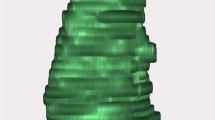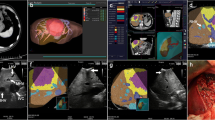Abstract
In our efforts to develop a guidance system for laparoscopic liver surgery, we are working towards a live animal tumor model. The objective of this study was to establish the tumor model for live porcine liver, visible on both computed tomography (CT) and ultrasound images. The tumor model was created by injecting a mixture of agarose, sephadex, and glycerol. Together with water, the mixture was heated to bring its components into solution. Once heating was complete, methylthionine chloride and CT contrast were added. Using laparoscopic ultrasound guidance, the tumor model mixture was injected into in vivo porcine liver. The resulting model tumors were radiolucent, visible on both CT and conventional X-ray. They appeared as hyperechoic lesions on ultrasound images. Compared to the CT images, the model tumors in the ultrasound images showed good correspondence in size. We conclude that our tumor model, due to its clearly identifiable nature on multiple imaging modalities, is a valuable tool for further studies on laparoscopic ultrasound (2D and 3D) and navigated ultrasound in laparoscopic surgery of the liver and other organs in a pre-clinical set-up.





Similar content being viewed by others
References
Baumhauer M, Feuerstein M, Meinzer HP, Rassweiler J. Navigation in Endoscopic Soft Tissue Surgery: Perspectives and Limitations. Journal of Endourology. 2008;22(4):751–66.
Estépar RSJ, Stylopoulos N, Ellis RE, Samset E, Westin CF, Thompson C, Vosburgh K. Towards scarless surgery: An endoscopic ultrasound navigation system for transgastric access procedures. Computer Aided Surgery 2007;12(6):311–24.
Feuerstein M, Reichl T, Vogel J, Schneider A, Feussner H, Navab N. Magneto-optic tracking of a flexible laparoscopic ultrasound transducer for laparoscope augmentation. LNCS, Proc Int Conf Med Image Comput Computer-Assisted Intervention (MICCAI) 2007;4791(Part I):458–66.
Hildebrand P, Schlichting S, Martens V, Besirevic A, Kleemann M, Roblick U, Mirow L, Burk C, Schweikard A, Bruch HP. Prototype of an intraoperative navigation and documentation system for laparoscopic radiofrequency ablation: first experiences. Eur J Surg Oncol 2008;34(4):418–21.
Solberg OV, Langø T, Tangen GA, Mårvik R, Ystgaard B, Rethy A, Hernes TAN. Navigated ultrasound in laparoscopic surgery. Minim Invasive Ther Allied Technol (MITAT) 2009;18(1):36–53.
Restrepo JI, Stocchi L, Nelson H, Young-Fadok TM, Larson DR, Ilstrup DM. Laparoscopic ultrasonography: a training model. Dis Colon Rectum 2001;44:632–7.
Scott DM, Young WN, Watumull LM, Lindberg G, Fleming JB, Rege RV, Brown RJ, Jones DB. Development of an in vivo tumor-mimic model for learning radiofrequency ablation. J Gastrointest Surg 2000;4:620–5.
Eide KR, Ødegård A, Myhre HO, Lydersen S, Hatlinghus S, Haraldseth O. DynaCT during EVAR—A Comparison with Multidetector CT. Eur J Vasc Endovasc Surg 2009;37:23–30.
Acknowledgements
This study was supported by SINTEF (Trondheim, Norway), The Ministry of Health and Social Affairs of Norway, through the National Center for 3D Ultrasound in Surgery (Trondheim, Norway), project 196726/V50 eMIT (Enhanced minimally invasive therapy, FRIMED program), and the Future Operating Room project at St. Olavs Hospital (Trondheim, Norway). We would like to thank Kirsten Rønning and Anne Karin Wik for valuable help during the experiments in the OR.
Author information
Authors and Affiliations
Corresponding author
Additional information
Grant support
See Acknowledgements section.
Rights and permissions
About this article
Cite this article
Rethy, A., Langø, T., Aasland, J. et al. Development of a Multimodal Tumor Model for Porcine Liver. J Gastrointest Surg 14, 1969–1973 (2010). https://doi.org/10.1007/s11605-010-1283-y
Received:
Accepted:
Published:
Issue Date:
DOI: https://doi.org/10.1007/s11605-010-1283-y




